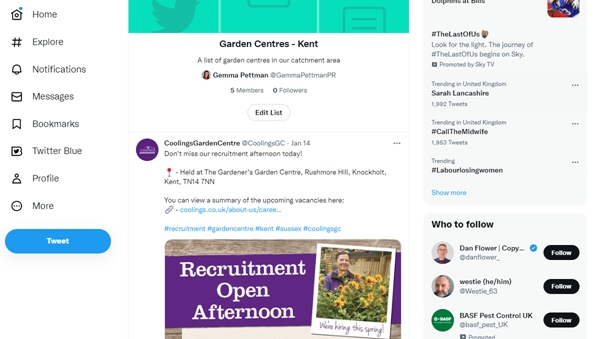Twitter lists: Save time and get straight to the good stuff
Twitter is a flutter at the arrival of a new ‘For You’ feed alongside the standard ‘Following’ feed. Users of platforms like TikTok will be familiar with these twin feeds but I have seen it cause a little consternation on the bird app. Seemingly, a lot of us just want to hear from the people we have chosen to hear from, which is fair enough. We don’t necessarily want an algorithm to guess who else we might like to follow.
If your feed is now something of a mishmash, you’re going to find Twitter Lists helpful so I have dived into my archive and updated this ‘how to’ post, which I first shared in 2016.
Despite having been around for years I’m still surprised by how few people use Twitter Lists. Mine save time, cut out a lot of the noise and help me to find relevant information really quickly. If you follow more than a few hundred accounts I don’t know how you sort the updates that are important to you from the rest of the content that’s being shared. Have you not worn your scrolling thumb out?
To spare you from RSI and help to you get to the good stuff more quickly, here’s a simple run-down on Twitter Lists:
How lists are going to help you
In short, Twitter Lists help you to organise the people you follow. You can group them together by topic, location, profession and so on, and then see what they are talking about. By way of an example, let’s assume you’re a charity concerned with providing horticultural training and employment for people with disabilities, you might create lists of:
- Charities across the country that provide similar services
- Disability rights groups
- Garden centres in your local area
We’ll return to this example but finding people who are working in your field or talking about topics you care about and creating lists around them mean you have a constant source of relevant information at your fingertips. This is hugely useful whether you’re looking to learn more about an issue or are sourcing relevant content to share with your own audiences. Lists can be public and therefore widely visible, or private and only visible to the person who created them.
Where lists are located
Lists can be found via your profile page:
- On the app on your phone, click on your avi and you’ll see a navigation list which includes your Topics, Bookmarks and Lists.
- On your desktop, Lists are hidden behind the ‘more’ tab.
In the top right corner of the Lists screen are three dots. Click this icon and you’ll see ‘Lists you’re on’. People have added me to all sorts, including charities, social media, female freelancers and ‘good at puns’ (very proud of this one!) because these are some of the topics I tweet about. If you don’t use Lists there won’t be anything on your Lists page, so let’s put that right.
Getting started: Using other people’s lists
It was my search for existing Lists that prompted this post back in 2016, so I’ll start with how you can use other people’s creations.
Pick someone you follow and visit their profile page. By clicking on the three dots in the top right corner, you can view their lists. Click on the title to open the list and you will be able to see tweets from members, who the members are and who subscribes to the list. If you like what you see, you can follow the list. Simple as that! Lists you follow appear on your own lists page.
Getting started: Setting up your own lists
Going back to the example I used earlier of the horticultural training charity, they may choose to set up a list of garden centres in their local area. To do this, start on the ‘Lists’ page, click the ‘New List’ icon (this looks like a list with a plus symbol):
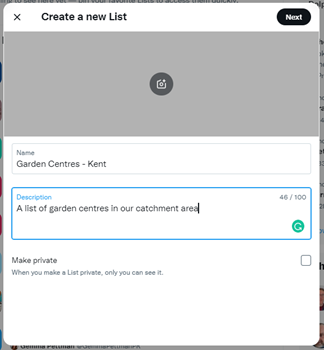
You can give the list a name and a description and choose whether to make the list private (so only you can see it). In this case, the list will be public and therefore visible to anyone. Once you have saved the list, you can start adding people to it:
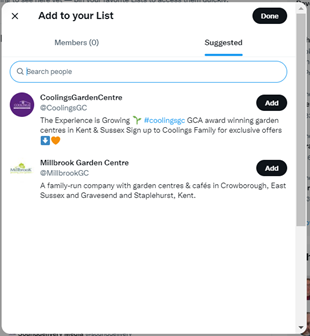
As you can see, Twitter suggests accounts you might like to add or you can use the search bar to find and add accounts yourself. The third option is to add them from your ‘Following’ feed. If you choose to add people in this way, click the three dots by their name and select ‘Add/remove from Lists’ and you can select which of your lists you want to add them to:
There are some useful things to note about creating lists:
- You are limited to creating 1000 lists
- Your lists cannot have more than 5000 members each (why you would want to have that many people I don’t know, as you’re back to the same information overload as you had from your pre-list timeline)
- Private lists are totally private and only the creator can see them. Even the people on the list won’t know they’re on there.
- You can add people you don’t follow to your lists
- You can pin the lists you look at most often to the top of your Lists page
Maintaining and managing lists
Once your lists are up and running you can add more people to them as you go along. Whether you’re on a computer or another device, the route to do this is via the three dots on an account’s profile page and selecting ‘Add/remove from Lists’:
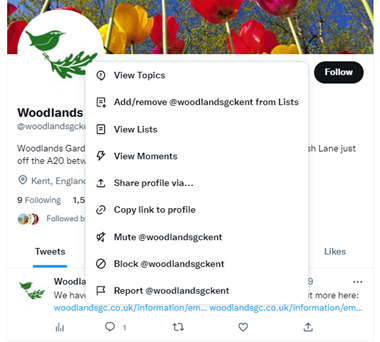
Open your list to edit the title and description, or to delete it, and remove people via the three dots next to their name.
Using your lists
Alongside (or perhaps instead of) your main timeline you can now scroll through what people on your individual lists are saying. Taking the Garden Centres list as an example, the tweets we see are only those from the list members:
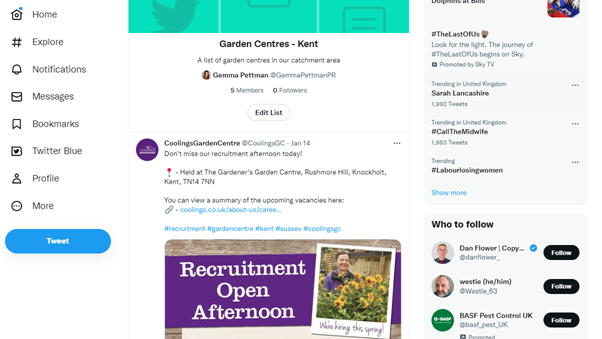
Might Twitter Lists improve your experience on the platform? Hopefully, this post has given you enough of an overview to get cracking. Pop ‘create Twitter lists’ on your to do list and let me know how you get on.
Tags In
Categories
- Content Creation (3)
- Events (6)
- Freelance Life (5)
- Guest Post (1)
- Media Relations (2)
- Social Media (11)
- Storytelling (8)
- Tips & tricks (9)
- Volunteering (5)

